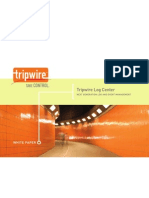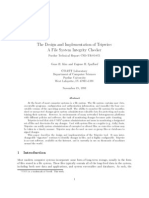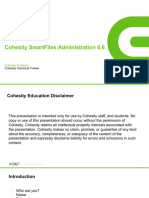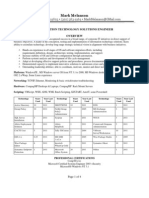Tripwire Cheatsheet
Tripwire Cheatsheet
Uploaded by
digitaltvguyCopyright:
Available Formats
Tripwire Cheatsheet
Tripwire Cheatsheet
Uploaded by
digitaltvguyCopyright
Available Formats
Share this document
Did you find this document useful?
Is this content inappropriate?
Copyright:
Available Formats
Tripwire Cheatsheet
Tripwire Cheatsheet
Uploaded by
digitaltvguyCopyright:
Available Formats
: llm4-lab3-exercise-2
1/10/11 10:33 PM
llm4-lab3-exercise-2
Tripwire
One of the first things you should do after building any new system is to get a snap shot of a known good state of the system before the system is contaminated or before deploying the system into production. There are several tools available for doing this. One of such tools is tripwire. Tripwire tries to do so much at time that it can be quite a difficult program to use. So brace yourself for a plethora of options, syntax, idiosyncrasies and switches. Tripwire can be regarded as a form of a host based intrusion detection system (IDS). It performs its so called intrusion detection function by taking a snapshot of a "healthy system" and later on comparing this healthy state with any other suspect states. It provides a means of knowing/monitoring whether certain sensitive files have been altered illegally. The system administrator of course decides what files are to be monitored. The authors of tripwire describe it as an Open Source Security, Intrusion Detection, Damage Assessment and Recovery, Forensics software. Tripwire simply compares a files new signature with that taken when the database was initially created. The steps involved in installing and configuring tripwire are as listed below: i. Install the software from source or binary ii. Run the configuration script: (twinstall.sh). This script is used to: a) Create the site key and the local key and prompts for pass phrases for both b) Sign the policy file and configuration file with the site key. iii. Initialize the tripwire database iv. Run the first integrity check. v. Edit the configuration file (twcfg.txt) vi. Edit the policy file (twpol.txt) Tripwire accepts the following command line options: Database Initialization mode: -m i --init -v --verbose -s --silent, --quiet -c cfgfile --cfgfile cfgfile -p polfile --polfile polfile -d database --dbfile database -S sitekey --site-keyfile sitekey -P passphrase --local-passphrase passphrase -L localkey --local-keyfile localkey -e --no-encryption The -v and -s options are mutually exclusive. The -L and -e options are mutually exclusive. The -P and -e options are mutually exclusive. Integrity Check mode: -m c --check -I --interactive
http://www.labmanual.org/tiki-print.php?page_ref_id=1449&page=llm4-lab3-exercise-2 Page 1 of 6
: llm4-lab3-exercise-2
1/10/11 10:33 PM
-v --verbose -s --silent, --quiet -c cfgfile --cfgfile cfgfile -p polfile --polfile polfile
-S sitekey --site-keyfile sitekey -L localkey --local-keyfile localkey -d database --dbfile database -r report --twrfile report -P passphrase --local-passphrase passphrase -n --no-tty-output -V editor --visual editor -E --signed-report -R rule --rule-name rule -l {level | name} --severity {level | name} -x section --section section -i list --ignore list -M --email-report -t { 0|1|2|3|4 } --email-report-level { 0|1|2|3|4 } [object1 object2...] The -v and -s options are mutually exclusive. The -l and -R options are mutually exclusive. The -P option is only valid with -E or -I. The -V option is only valid with -I. The -t option is only valid with -M. Specifying objects overrides the -l and -R options. Database Update mode: -m u --update -v --verbose -s --silent, --quiet -c cfgfile --cfgfile cfgfile -p polfile --polfile polfile -S sitekey --site-keyfile sitekey -L localkey --local-keyfile localkey -d database --dbfile database -r report --twrfile report -P passphrase --local-passphrase passphrase -V editor --visual editor -a --accept-all -Z {low | high} --secure-mode {low | high} The -v and -s options are mutually exclusive. The -a and -V options are mutually exclusive.
Policy Update mode: -m p --update-policy -v --verbose -s --silent, --quiet -c cfgfile --cfgfile cfgfile -p polfile --polfile polfile
http://www.labmanual.org/tiki-print.php?page_ref_id=1449&page=llm4-lab3-exercise-2 Page 2 of 6
: llm4-lab3-exercise-2
1/10/11 10:33 PM
-S sitekey --site-keyfile sitekey -L localkey --local-keyfile localkey -d database --dbfile database -P passphrase --local-passphrase passphrase -Q passphrase --site-passphrase passphrase -Z {low | high} --secure-mode {low | high} policyfile.txt The -v and -s options are mutually exclusive. Test mode: -m t --test -e user@domain.com --email user@domain.com Only one address may be entered.
Summary Of Options for the tripwire command: Database Initialization: tripwire --init options Integrity Checking: tripwire --check [object1 object2...] Database Update: tripwire --update Policy Update: tripwire --update-policy policyfile.txt Test: tripwire --test --email address twadmin The twadmin utility is used to perform administrative functions related to tripwire files and configuration options. Specifically, twadmin allows encoding, decoding, signing, and verification of tripwire files, and provides a means to generate and change local and site keys. Create Configuration File: twadmin --create-cfgfileoptions cfgfile.txt Print Configuration File: twadmin --print-cfgfile options Create Policy File: twadmin --create-polfile options polfile.txt Print Policy File: twadmin --print-polfile options Remove Encryption: twadmin --remove-encryption options file1... Encryption: twadmin --encrypt options file1... Examine Encryption: twadmin --examine options file1... Generate Keys: twadmin --generate-keys options twprint Prints Tripwire database and report files in clear text format. Print Report mode: -m r --print-report -v --verbose -s --silent, --quiet -c cfgfile --cfgfile cfgfile -r report --twrfile report -L localkey --local-keyfile localkey -t { 0|1|2|3|4 } --report-level { 0|1|2|3|4 } Print Database mode: -m d --print-dbfile
http://www.labmanual.org/tiki-print.php?page_ref_id=1449&page=llm4-lab3-exercise-2 Page 3 of 6
: llm4-lab3-exercise-2
1/10/11 10:33 PM
-v --verbose -s --silent, --quiet -c cfgfile --cfgfile cfgfile -d database --dbfile database -L localkey --local-keyfile localkey [object1 object2 ...
siggen siggen is a signature gathering routine for Tripwire. It is a utility that displays the hash function values for the specified files. Usage: siggen options file1 file2... -t --terse -h --hexadecimal -a --all -C --CRC32 -M --MD5 -S --SHA -H --HAVAL file1 file 2 ...
Exercise 2
To install Tripwire 1. Check to see if you already have tripwire installed on your system. Type: root@localhost root# rpm -q tripwire tripwire-* If you get an output similar to the one above then you already have it installed. Skip the next step. 2. If you dont have it installed, obtain the tripwire binary and install it. Type: root@localhost root# rpm -Uvh tripwire*
To Configure tripwire Configuring tripwire involves customizing the tripwire configuration file if needed, then customizing the policy file if needed and then running the configuration script which will prompt you for a passphrase that will be used to sign/protect the configuration file, the policy file and the database file.
1. Change your pwd to the tripwires working directory: Type: root@localhost root# cd /etc/tripwire/ 2. List the contents of the directory here:
3. Use any pager or text editor to view/study the files in the directory.
http://www.labmanual.org/tiki-print.php?page_ref_id=1449&page=llm4-lab3-exercise-2
Page 4 of 6
: llm4-lab3-exercise-2
1/10/11 10:33 PM
4. We will accept the settings that come with the default config. file (twcfg.txt) and the provided default policy file (twpol.txt) for now. 5. Execute the tripwire configuration script as root. Type: root@localhost tripwire# ./twinstall.sh You will be prompted (twice) for site keyfile passphrase. Select any passphrase that you WILL NOT forget ( The site key is meant for the twcfg.txt file and the twpol.txt file) Enter the site keyfile passphrase: Verify the site keyfile passphrase: Next you will be prompted for a local key. Again select another password YOU WILL not forget. ( The local key signs the tripwire database files and the reports files) Enter the local keyfile passphrase: Verify the local keyfile passphrase: After choosing your passphrases the twinstall.sh script will then proceed with the actual creation/signing of the encrypted versions of the original plain text files ( i.e tw.cfg and tw.pol will be created respectively) You will be prompted again for the passphrases you choose earlier. At this point just follow the prompts until the script exits. 6. List the new contents of the /etc/tripwire directory.
7. Per the warning you got while the twinstall.sh script was running, you will now move the plain text versions of the configuration file and policy files away from the local system. You could store them on a floppy disk if you want or completely delete them if you are feeling particularly daring. Type: root@localhost tripwire# mount /dev/fd0 && mv twcfg.txt twpol.txt /mnt/floppy/
NOTE: It may be useful to keep the plain text versions in safe place, just incase you forget your passphrases. You can then always re-run the twinstall.sh script based on the configurations and policies you have fine tuned over time.
To initialize the database Initializing the database is the tripwire terminology for, taking an initial untainted snapshot of the files you have decided to monitor (based on the policy file). This generates the database and also signs the database with the local key. The database serves as the baseline for all future integrity checks. 1. While still logged in as root type: root@localhost tripwire# tripwire - - init Please enter your local passphrase: Parsing policy file: /etc/tripwire/tw.pol Generating the database... Processing Unix File System ***
http://www.labmanual.org/tiki-print.php?page_ref_id=1449&page=llm4-lab3-exercise-2
Page 5 of 6
: llm4-lab3-exercise-2
1/10/11 10:33 PM
Enter your local passphrase when prompted. The database creation will run to conclusion and you should get an output similar to the one below: The database was successfully generated. 2. Use the ls command to verify that the database was indeed created under the stated location. Type: root@localhost tripwire# ls -lh /var/lib/tripwire/$(hostname).twd -rw-r--r-- 1 root root 1.9M Jul 4 17:43 /var/lib/tripwire/localhost.localdomain.twd
Created by: system. Last Modification: Sunday 16 of November, 2008 17:27:09 EST by wale. The original document is available at http://www.labmanual.org/tiki-index.php ?page=llm4-lab3-exercise-2
http://www.labmanual.org/tiki-print.php?page_ref_id=1449&page=llm4-lab3-exercise-2
Page 6 of 6
You might also like
- Wa8551 Va8551studDocument1,236 pagesWa8551 Va8551studAlfredo OjedaNo ratings yet
- EXAMTOPICS Quiz GCPDocument43 pagesEXAMTOPICS Quiz GCPRathika GowriNo ratings yet
- ZFSDocument24 pagesZFSAlphaQ by raks100% (1)
- Adme Q & A: Question & AnswerDocument3 pagesAdme Q & A: Question & AnswerRafael Herrera PinedaNo ratings yet
- Forwarder-7 2 1-ForwarderDocument144 pagesForwarder-7 2 1-ForwarderRaghavNo ratings yet
- DS8 STS 20feb2012 PDFDocument525 pagesDS8 STS 20feb2012 PDFMassimo GampoliNo ratings yet
- A Quick Step by Step Guide For Oracle 11g R2 Installation On Red Hat Enterprise Linux 5Document6 pagesA Quick Step by Step Guide For Oracle 11g R2 Installation On Red Hat Enterprise Linux 5Rakesh KumarNo ratings yet
- Node Reset&AddDocument3 pagesNode Reset&AddNAGARJUNANo ratings yet
- Websphere Application Server: Muhammad QasimDocument24 pagesWebsphere Application Server: Muhammad QasimMuhammad Qasim HussainNo ratings yet
- Data Integrity With RubrikDocument10 pagesData Integrity With RubrikMagesh PerumalNo ratings yet
- Tripwire Enterprise File Integrity Manager Datasheet PDFDocument4 pagesTripwire Enterprise File Integrity Manager Datasheet PDFashok kalaguntaNo ratings yet
- HSD Rapport Data DiodesDocument48 pagesHSD Rapport Data DiodesStephanie DMNo ratings yet
- 1 10527 Tripwire Data Protection 2 0 WPDocument9 pages1 10527 Tripwire Data Protection 2 0 WPmohhmadrdNo ratings yet
- 1602 07467Document54 pages1602 07467Roxana ElenaNo ratings yet
- Tripwire Log CenterDocument5 pagesTripwire Log CenterebathNo ratings yet
- Nutanix Security Guide v6 - 6 - CompressedDocument233 pagesNutanix Security Guide v6 - 6 - CompressedmaiksonNo ratings yet
- Design and Implementation of TripwireDocument21 pagesDesign and Implementation of TripwireVikas JainNo ratings yet
- New York State Dedicated Highway and Bridge Trust Fund CrossroadsDocument18 pagesNew York State Dedicated Highway and Bridge Trust Fund CrossroadsNews10NBCNo ratings yet
- Cohesity SmartFiles Administration 6.6Document351 pagesCohesity SmartFiles Administration 6.6majidqaziNo ratings yet
- Module 1 - Avamar FundamentalsDocument52 pagesModule 1 - Avamar FundamentalsRazu MollahNo ratings yet
- Setup Guide C5000Document40 pagesSetup Guide C5000majidqaziNo ratings yet
- Gluster File System 3.3.0Document144 pagesGluster File System 3.3.0Leandro CésarNo ratings yet
- Nginx Interview QuestionsDocument5 pagesNginx Interview QuestionsSanket PandhareNo ratings yet
- DevSecOps ReferenceDocument31 pagesDevSecOps ReferenceMarcelo JuniorNo ratings yet
- Cyber Recovery On AWS FAQDocument7 pagesCyber Recovery On AWS FAQacerkingNo ratings yet
- Tripwire ReportDocument34 pagesTripwire ReportSanjeev Yadav75% (4)
- Ipmi Server ManagementDocument21 pagesIpmi Server Managementsjtu1234567No ratings yet
- Robocopy and A Few ExamplesDocument6 pagesRobocopy and A Few ExamplesSagala AmbarNo ratings yet
- TenableCOre NessusDocument84 pagesTenableCOre NessusLanang FebriramadhanNo ratings yet
- Tripwire Executives Guide To The Cis Controls PDFDocument19 pagesTripwire Executives Guide To The Cis Controls PDFcheenuNo ratings yet
- Endpoint Security Agent: Agent Administration Guide Release 29Document151 pagesEndpoint Security Agent: Agent Administration Guide Release 29hbnjknwvnffkjrpaadttirvorgNo ratings yet
- Deep Security 96 SP1 Install Guide Basic enDocument88 pagesDeep Security 96 SP1 Install Guide Basic enmkavinmcaNo ratings yet
- Brksec 2020Document189 pagesBrksec 2020Azad AliNo ratings yet
- SG - EMC Avamar Installation ND Configuration Lab GuideDocument322 pagesSG - EMC Avamar Installation ND Configuration Lab GuideRazu MollahNo ratings yet
- IBM Data Center NetworkingDocument260 pagesIBM Data Center NetworkingBernabeNo ratings yet
- Configure A Load Balancer For An Always On Availability Group in AzureDocument13 pagesConfigure A Load Balancer For An Always On Availability Group in AzureSorinNo ratings yet
- LTM Fundamentals: Mohit GuptaDocument105 pagesLTM Fundamentals: Mohit GuptaAns SembiringNo ratings yet
- API - Rubrik SDK For Python 5.0-V2Document4 pagesAPI - Rubrik SDK For Python 5.0-V2BerthetNo ratings yet
- h15523 Adme Configuration Steps and Screenshots With Networker As Backup SoftwareDocument31 pagesh15523 Adme Configuration Steps and Screenshots With Networker As Backup SoftwareRafael Herrera PinedaNo ratings yet
- Oracle Linux Release Notes For Oracle Linux 7 Update 3Document50 pagesOracle Linux Release Notes For Oracle Linux 7 Update 3Vipul WankarNo ratings yet
- Red Hat Enterprise Linux-8-8.3 Release Notes-En-UsDocument154 pagesRed Hat Enterprise Linux-8-8.3 Release Notes-En-Uskamel najjarNo ratings yet
- CommVault Simpana 9 and Data DomainDocument82 pagesCommVault Simpana 9 and Data DomainjawaharbabuNo ratings yet
- Windows Unified Host Utilities 7.0: Installation GuideDocument64 pagesWindows Unified Host Utilities 7.0: Installation GuidetungNo ratings yet
- Implementing Cisco Business Edition 6000Document11 pagesImplementing Cisco Business Edition 6000chromeshNo ratings yet
- Tripwire Enterprise Manager WindowsDocument6 pagesTripwire Enterprise Manager WindowsSuresh Kumar RaajendiranNo ratings yet
- Compellent Storage Center Linux Best PracticesDocument45 pagesCompellent Storage Center Linux Best PracticesibmmasterNo ratings yet
- 5 Ansible Interview QuestionsDocument5 pages5 Ansible Interview Questionsrocksolidtrade007No ratings yet
- Command Reference-NOS v4 0Document167 pagesCommand Reference-NOS v4 0Kamal MoulineNo ratings yet
- Ma Network Automation For Everyone Ebook 511700 202309 enDocument18 pagesMa Network Automation For Everyone Ebook 511700 202309 enbedoui marwenNo ratings yet
- Brkaci 1000Document80 pagesBrkaci 1000Fabricio CRNo ratings yet
- Session Title:: IBM Power Systems Technical UniversityDocument59 pagesSession Title:: IBM Power Systems Technical Universityulysses_ramosNo ratings yet
- Image Guide of OpenstackDocument101 pagesImage Guide of OpenstackAbdou MfopaNo ratings yet
- Virtual Server EnvironmentDocument2 pagesVirtual Server Environmentsapa3No ratings yet
- IPv4 Addressing SubnettingDocument91 pagesIPv4 Addressing SubnettingRABIUL ISLAM100% (1)
- CV Martin VoelkDocument8 pagesCV Martin VoelkMonikaTheBestNo ratings yet
- Desktop Architect in Philadelphia PA Resume Mark MelansonDocument4 pagesDesktop Architect in Philadelphia PA Resume Mark MelansonMarkMelanson1No ratings yet
- Veritas Cluster Server-VCSDocument72 pagesVeritas Cluster Server-VCSsumit04_28No ratings yet
- Vsphere Admin6 AOS v6 - 6Document107 pagesVsphere Admin6 AOS v6 - 6Bauke PluggeNo ratings yet
- Red Hat Enterprise Linux 9 Administration: A comprehensive Linux system administration guide for RHCSA certification exam candidatesFrom EverandRed Hat Enterprise Linux 9 Administration: A comprehensive Linux system administration guide for RHCSA certification exam candidatesNo ratings yet
- OSCP_MemDump_IN_2022_CAN39721Document15 pagesOSCP_MemDump_IN_2022_CAN39721mhfehackifyNo ratings yet
- E Finance Proposal 1Document33 pagesE Finance Proposal 1Aarju PoudelNo ratings yet
- Site-to-Site IPSec Excessive Rekeying On Only One Tunnel On System LogsDocument4 pagesSite-to-Site IPSec Excessive Rekeying On Only One Tunnel On System LogsankitNo ratings yet
- Networksecuritymodule2drshivashankar 230408045636 34a280c8Document24 pagesNetworksecuritymodule2drshivashankar 230408045636 34a280c8Dr. Shiva shankarNo ratings yet
- Operating System Overview Module 1-Aeraxia - inDocument86 pagesOperating System Overview Module 1-Aeraxia - insk10000067No ratings yet
- STAFF SELECTION COMMISSION (SSC) - Department of Personnel & TrainingDocument1 pageSTAFF SELECTION COMMISSION (SSC) - Department of Personnel & TrainingYadav KingNo ratings yet
- Bank Project FinalDocument32 pagesBank Project Finalmayankdevsingh4No ratings yet
- Quiz Questions - Answers Quiz Questions - AnswersDocument1 pageQuiz Questions - Answers Quiz Questions - AnswersJohn DoeNo ratings yet
- RPC AppGuard Testing White PaperDocument3 pagesRPC AppGuard Testing White PaperLuc BraNo ratings yet
- 1st Quarter Exam in TLE 7Document4 pages1st Quarter Exam in TLE 7ronniefernandez.817No ratings yet
- Iso 27032 Lead Cyber Security ManagerDocument5 pagesIso 27032 Lead Cyber Security ManagerNicholasFCheongNo ratings yet
- CS409-M1-Cryptography and Network Security-Ktustudents - inDocument9 pagesCS409-M1-Cryptography and Network Security-Ktustudents - inFadil basheerNo ratings yet
- Definition of Computer SecurityDocument13 pagesDefinition of Computer SecuritysuhanitaNo ratings yet
- Popular SonicWall Firewall ConfigurationsDocument5 pagesPopular SonicWall Firewall ConfigurationsKashif Aziz AwanNo ratings yet
- Step by Step Configure Router Vyata 6.5.19Document11 pagesStep by Step Configure Router Vyata 6.5.19gepenks831No ratings yet
- Bcos 183Document18 pagesBcos 183icaibosinterNo ratings yet
- The Unified Kill ChainDocument19 pagesThe Unified Kill ChainManuNo ratings yet
- Cyber Security Q and ADocument14 pagesCyber Security Q and ADeepika100% (1)
- 1.1 Introducing-pfSenseDocument2 pages1.1 Introducing-pfSensesomayeh mosayebzadehNo ratings yet
- Nuratiah Binti Saberi AnswerDocument4 pagesNuratiah Binti Saberi AnswerAre-ThieYa YaYaNo ratings yet
- The Hacker, Hacking Tactics and The VictimDocument38 pagesThe Hacker, Hacking Tactics and The VictimSarah Jane DiazNo ratings yet
- AnexGATE AG25Document2 pagesAnexGATE AG25suman1410No ratings yet
- IAM DeveloperDocument5 pagesIAM Developerabhay.rajauriya1No ratings yet
- Mobile Technologies SecurityDocument16 pagesMobile Technologies SecurityGi Hyeon LeeNo ratings yet
- GNAT 10849001 Written Question AnsDocument7 pagesGNAT 10849001 Written Question Anshamid116422No ratings yet
- CISCO CiberSecurity Essentials v1 Capitulo 4 Arte Proteger SecretosRDocument29 pagesCISCO CiberSecurity Essentials v1 Capitulo 4 Arte Proteger SecretosRlleykersantostorres890No ratings yet
- شيفرة مورس PDFDocument17 pagesشيفرة مورس PDFpeter markNo ratings yet
- Aaron AlexanderDocument10 pagesAaron Alexandertech2clickNo ratings yet
- Asoft IPG: Merchant Integration Compliance Verification DocumentDocument19 pagesAsoft IPG: Merchant Integration Compliance Verification DocumentRafting TaraNo ratings yet

























































































